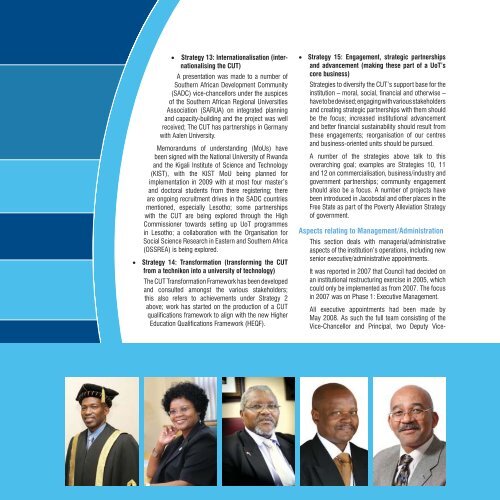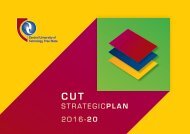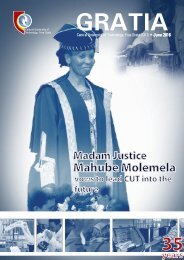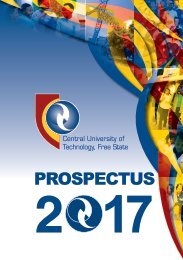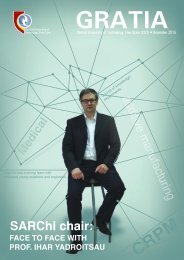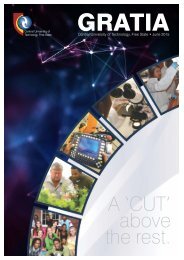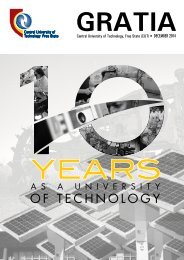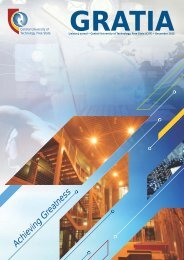CUT Annual Report 2008
The Annual Report is a premier publication that reports on institutional development and successes.
The Annual Report is a premier publication that reports on institutional development and successes.
Create successful ePaper yourself
Turn your PDF publications into a flip-book with our unique Google optimized e-Paper software.
• Strategy 13: Internationalisation (internationalising<br />
the <strong>CUT</strong>)<br />
A presentation was made to a number of<br />
Southern African Development Community<br />
(SADC) vice-chancellors under the auspices<br />
of the Southern African Regional Universities<br />
Association (SARUA) on integrated planning<br />
and capacity-building and the project was well<br />
received; The <strong>CUT</strong> has partnerships in Germany<br />
with Aalen University.<br />
Memorandums of understanding (MoUs) have<br />
been signed with the National University of Rwanda<br />
and the Kigali Institute of Science and Technology<br />
(KIST), with the KIST MoU being planned for<br />
implementation in 2009 with at most four master’s<br />
and doctoral students from there registering; there<br />
are ongoing recruitment drives in the SADC countries<br />
mentioned, especially Lesotho; some partnerships<br />
with the <strong>CUT</strong> are being explored through the High<br />
Commissioner towards setting up UoT programmes<br />
in Lesotho; a collaboration with the Organisation for<br />
Social Science Research in Eastern and Southern Africa<br />
(OSSREA) is being explored.<br />
• Strategy 14: Transformation (transforming the <strong>CUT</strong><br />
from a technikon into a university of technology)<br />
The <strong>CUT</strong> Transformation Framework has been developed<br />
and consulted amongst the various stakeholders;<br />
this also refers to achievements under Strategy 2<br />
above; work has started on the production of a <strong>CUT</strong><br />
qualifications framework to align with the new Higher<br />
Education Qualifications Framework (HEQF).<br />
• Strategy 15: Engagement, strategic partnerships<br />
and advancement (making these part of a UoT’s<br />
core business)<br />
Strategies to diversify the <strong>CUT</strong>’s support base for the<br />
institution – moral, social, financial and otherwise –<br />
have to be devised; engaging with various stakeholders<br />
and creating strategic partnerships with them should<br />
be the focus; increased institutional advancement<br />
and better financial sustainability should result from<br />
these engagements; reorganisation of our centres<br />
and business-oriented units should be pursued.<br />
A number of the strategies above talk to this<br />
overarching goal; examples are Strategies 10, 11<br />
and 12 on commercialisation, business/industry and<br />
government partnerships; community engagement<br />
should also be a focus. A number of projects have<br />
been introduced in Jacobsdal and other places in the<br />
Free State as part of the Poverty Alleviation Strategy<br />
of government.<br />
Aspects relating to Management/Administration<br />
This section deals with managerial/administrative<br />
aspects of the institution’s operations, including new<br />
senior executive/administrative appointments.<br />
It was reported in 2007 that Council had decided on<br />
an institutional restructuring exercise in 2005, which<br />
could only be implemented as from 2007. The focus<br />
in 2007 was on Phase 1: Executive Management.<br />
All executive appointments had been made by<br />
May <strong>2008</strong>. As such the full team consisting of the<br />
Vice-Chancellor and Principal, two Deputy Vice-<br />
8


